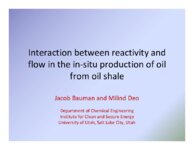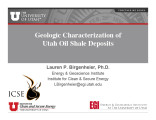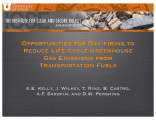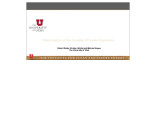TO
Filters: Research Institute: "Institute for Clean and Secure Energy (ICSE)" Collection: "ir_eua" School Or College: "University of Utah" Format: "application/pdf"
| Title | Date | Subject | Description | ||
|---|---|---|---|---|---|
| 1 |
 |
A technical, economic, and legal assessment of North American heavy oil, oil sands, and oil shale resources: In response to Energy Policy Act of 2005 Section 369(p) | 2007-09 | Oil sands; Oil shale; Heavy oil; Energy Policy Act; 2005; Climate Change; Petroleum; Oil Cost; United States; North American heavy oil; Utah Heavy Oil Program; UHOP; World economic development; Energy; Canadian oil sands; Unconventional resources ;Technical; Economic; Legal assessment | Against the backdrop of world population growth, rapid economic expansion in the world's most populous countries, challenging political climates in many oil-producing nations, and the specter of climate change, worldwide energy consumption is projected to increase from the 2004 level of just over 40... |
| 2 |
 |
Interaction between reactivity and flow in the in-situ production of oil from oil shale | 2009-10-23 | in situ; oil shale | In-situ Oil Shale Processing: 1) Underground resources are heated by some means to convert insoluable/ impermeable kerogen into oil and gas products. 2) The interlinked processes of heat transfer, kerogen conversion and flow are complex. 3) This paper is an attempt to understand these linkages. |
| 3 |
 |
Geologic characterization of Utah oil shale deposits | 2010-04-28 | oil shale development; geologic framework; lake evolution; oil shale; stratigraphic correlation | Why Geology? Economic prospectivity of oil shale development in the Uinta Basin relies heavily on establishing a solid geologic framework. Understanding lake evolution matters. |
| 4 |
 |
Pore scale analysis of oil shale pyrolysis by X-ray CT and LB simulation | 2010-09-09 | pore scale analysis; oil shale pyrolysis; X-ray CT; LB simulation; oil shale; shale oil procuction; pore structure | There are important questions concerning the quality and volume of pore space that is created when oil shale is pyrolyzed for the purpose of producing shale oil. In this paper, we pyrolyzed 1.9 cm diameter cores at different temperatures and heating rates. Detailed 3D imaging of the core before and ... |
| 5 |
 |
Clean and Secure Energy from Domestic Oil Shale and Oil Sands Resources: Quarterly progress report - January 2015 to March 2015 | 2015 | quarterly report; domestic oil shale resources; domestic oil sands resources; unconventional fuels; oil shale; oil sands | The Clean and Secure Energy from Domestic Oil Shale and Oil Sands Resources program, part of the research agenda of the Institute for Clean and Secure Energy (ICSE) at the University of Utah, is focused on engineering, scientific, and legal research surrounding the development of these resources in ... |
| 6 |
 |
University of Utah and Utah Geological Survey Green River coring project summary | 2015-07 | Green River coring project; Skyline 16; oil shale deposits; Green River Formation | The University of Utah's Institute for Clean and Secure Energy and the Utah Geological Survey teamed up to drill 1000 feet of 4-inch diameter core in the upper Green River Formation oil shale deposits in the eastern Uinta Basin, Utah. The purpose was to recover nearly the entire oil shale zone (Para... |
| 7 |
 |
Skyline 16 information | 2015-07 | Skyline 16; preliminary stratigraphy of Skyline 16; Green River Formation; Protecore samples | |
| 8 |
 |
Subtask 3.2: Flameless oxy-gas process heaters for efficient CO2 capture | 2011-03-11 | Oxy-gas process heaters; efficient CO2 capture; oxy-gas combustion | This is a presentation given at the Unconventional Fuels from Oil Shale and Oil Sands Project Review Meeting in March 10-11, 2011. |
| 9 |
 |
Subtask 6.1: Engineering process models for economic impact analysis | 2011-03-10 | engineering process models; economic impact analysis; domestic heavy oil; developing domestic heavy oil/sands/shale resources | A presentation given at the Unconventional Fuels from Oil Shale and Oil Sands Project Review Meeting on March 10-11, 2011. In the project objectives, the purpose of assessment is to "Examine limiting factors to the development of domestic heavy oil, oil sands, and oil shale resources. Identify poli... |
| 10 |
 |
Subtask 4.3: Multiscale thermal processing of oil shale | 2011-03-10 | thermal processing; oil shale; oil shale treatment; thermal treatment | |
| 11 |
 |
Subtask 4.4: Effect of oil shale processing on water composition | 2011-03-10 | oil shale processing; water composition; unconventional fuels; oil shale; oil sands; oil shale development | A presentation at the Unconventional Fuels from Oil Shale and Oil Sands Project Review Meeting on March 10-11, 2011. The overall goal is to asses aquifers in the Uinta Basin to determine where saline water (produced along with conventional petroleum development) can be disposed without harming fresh... |
| 12 |
 |
Opportunities for oxy-firing to reduce life-cycle greenhouse gas emissions from transportation fuels | 2011-03-10 | GHG; oxy-firing; reduce greenhouse gas emissions; transportation fuel emissions; CO2 analysis; oil sands | The outline covers in this presentation covers: GHGs and the transportation fuel cycle. Motivation for reducing GHG emissions. Use of oxy-firing for CO2 capture in refining of conventional fuel. Use of oxy-firing for extraction and upgrading of oil sands. GHG emissions from other scenarios Would oxy... |
| 13 |
 |
Development of HPC-based simulations tool for in situ thermal processing of oil shale/sands | HPC-based simulations tool; in situ thermal processing; oil shale; oil sands; commercial production of oil shale; ecoshale in-capsule process | A presentation given at the Unconventional Fuels from Oil Shale and Oil Sands Project Review Meeting on March 10-11, 2011. | |
| 14 |
 |
DOE project review: Subtask 4.2 (B): Examination of in situ production models | 2011-03-11 | DOE project review; in situ production models; oil shale; unconventional fuels; oil sands; geomechanics; general reservoir simulation tool | A presentation given at the Unconventional Fuels from Oil Shale and Oil Sands Project Review Meeting on March 10-11, 2011. The objectives of the presentation is the examination of in-situ production methods, different in-situ production method options, rigorous energy and carbon balances, exploratio... |
| 15 |
 |
Phase 2: Clean and secure energy from coal: Quarterly progress report: October 1, 2010 to December 31, 2010 | 2011-01-31 | domestic coal resources; CO2 capture; stationary power generation; LES; DQMOM approach; oxy-coal flames; coal | The University of Utah is pursuing research to utilize the vast energy stored in our domestic coal resources and to do so in a manner that will capture CO2 from combustion from stationary power generation. The research is organized around the theme of validation and uncertainty quantification throug... |
| 16 |
 |
Phase 2: Clean and secure energy from coal: Quarterly progress report: July 1, 2010 to September 30, 2010 | 2010-10-01 | domestic coal resources; CO2 capture; stationary power generation; Oxycoal; OFC; coal | The University of Utah is pursuing research to utilize the vast energy stored in our domestic coal resources and to do so in a manner that will capture CO2 from combustion from stationary power generation. The research is organized around the theme of validation and uncertainty quantification throug... |
| 17 |
 |
Phase 2: Clean and secure energy from coal: Quarterly progress report: April 1, 2010 to June 30, 2010 | 2010-08-01 | domestic coal resources; CO2 capture; stationary power generation; DQMOM approach | The University of Utah is pursuing research to utilize the vast energy stored in our domestic coal resources and to do so in a manner that will capture CO2 from combustion from stationary power generation. The research is organized around the theme of validation and uncertainty quantification throug... |
| 18 |
 |
Phase 2: Clean and secure energy from coal: Quarterly progress report: January 1, 2010 to March 31, 2010 | 2009-01-30 | domestic coal resources; ICSE; capture CO2; stationary power generation; velocity model; bitumous coal; coal | The University of Utah is pursuing research to utilize the vast energy stored in our domestic coal resources and to do so in a manner that will capture CO2 from combustion from stationary power generation. The research is organized around the theme of validation and uncertainty quantification throug... |
| 19 |
 |
A market assessment of heavy oil, oil sands, and oil shale resources | 2011-03-10 | unconventional fuels; market assessment; developing domestic heavy oil, oil sands, and oil shale resources; preliminary infrastructure needs | A presentation given at the Unconventional Fuels from Oil Shale and Oil Sands Project Review Meeting on March 10-11, 2011. |
| 20 |
 |
2012 Unconventional fuels conference introduction | 2012-05-15 | unconventional fuels; computational simulation and pilot-scale experiment; unconventional resources; emissions minimization; CO2 regulation; CO2 coal research | Presentation given at the 2012 Unconventional Fuels Conference. |
| 21 |
 |
Policy analysis of the Canadian oil sands experience | 2011-03-10 | policy analysis; Canadian oil sands experience; oil sands; federal oil sands resources; oil sands development; unconventional fuels | The presentation goes over analyzing the relevance of the Canadian experience to U. S. oil sands development. This report focuses on federal oil sands resources, specifically potential development in the STSA's. No Current development on federal lands, despite leasing authorization under the Combine... |
| 22 |
 |
Unconventional Fuels Conference: Oil shale and oil sands development in the western U. S. - Agenda | 2013-05-07 | unconventional fuels; oil shale development; oil sands development; agenda | Presentation given at the 2013 Unconventional Fuels Conference. |
| 23 |
 |
Wild lands and wilderness - Implications for Utah's unconventional fuels industry | 2011-05-17 | unconventional fuels industry; order 3310; maintain wilderness resource inventories; BLM; FLPMA; land management | Presentation given at the 2011 Unconventional Fuels Conference. |
| 24 |
 |
Effect of pressure on copper/copper-oxide system functioning as an oxygen carrier in chemical looping combustion | 2010-06-10 | copper/copper-oxide system; chemical looping combustion; CLC; high pressure thermogravimetic analysis | Chemical Looping Combustion (CLC) is a promising technology that will utilize more efficient harvesting of energy along with decreased CO2 emissions into the atmosphere. In CLC system the emissions are composed of CO2 and H2O allowing the CO2 to be captured and disposed of in an environmentally more... |
| 25 |
 |
Digital library and interactive map projects at the Institute for Clean and Secure Energy, University of Utah | 2009-10-23 | ICSE; digital repository | The Instituteʼs repository is a not-for-profit service for researchers, and we are working to include a variety of documents, data, and maps relevant to unconventional fuels research and development. |
